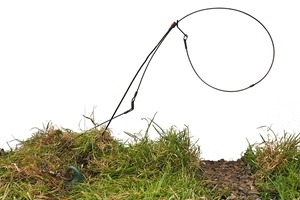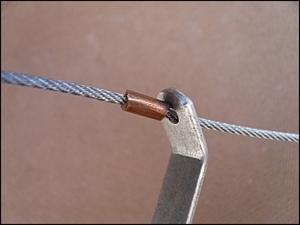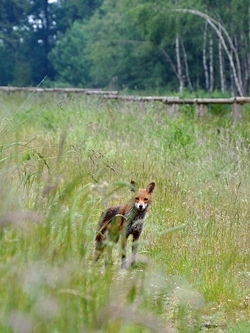 The new 2016 Code of best practice on the use of snares for fox control in England replaces the 2005 Defra CoP on snares, which had been left out of date by research. Its shift to become a sector-led code also reflects government policy. The publication of this document – and its counterpart in Wales – marks the culmination of a long research effort by the GWCT. This is a brief summary of that history.
The new 2016 Code of best practice on the use of snares for fox control in England replaces the 2005 Defra CoP on snares, which had been left out of date by research. Its shift to become a sector-led code also reflects government policy. The publication of this document – and its counterpart in Wales – marks the culmination of a long research effort by the GWCT. This is a brief summary of that history.
The researcher’s experience
In 1985, we were doing research that required us to catch foxes alive, attach radio collars, and release them in good condition. Although we tried persistently to catch them using baited cage traps, these were never successful and we repeatedly found clear evidence of trap-shyness. Conversely, we had considerable success with our own hand-made fox snares.
Foxes caught in snares for radio-tagging were not only alive and uninjured, but went on to live normal lives that could be followed by radio-tracking. This was noteworthy, because at the time there was already a strong lobby pressing for snares to be banned on grounds of cruelty, and their photographic evidence of injured or dead animals found in snares could not be denied. We began to consider why snares were benign in some circumstances but injurious in others. We also wondered how one could improve the chances of catching a fox while reducing the risk of catching non-targets.
Our experiences resulted in the publication of a GWCT leaflet ‘Guidance for the Snare User’ in 1998. This has now been through numerous updates, but most of its recommendations have remained unchanged since the first edition.
Today, we still use snares to catch foxes for radio-tagging, because of their remarkable effectiveness. Periodically we also make time to try cage traps again, because we’d love to clarify why they are so ineffectual. But to date we have not found a serious role for cage traps in rural areas.
Basic fact-finding
In 1992, we approached a sample of 45 gamekeepers – chosen to reflect the variety of shooting estates in Britain – asking them to keep a paper record for 12 months of all their fox control efforts. This showed that roughly one in five of the foxes they killed were taken using snares. Snares were used predominantly in the spring and summer months, a mirror image of the seasonal use of shooting. Understandably, snares come into their own when vegetation height makes shooting impossible. This is the time of year when the impact of fox predation is greatest, and therefore when control is most important for wild prey species and for livestock or poultry.
In 1994, a joint project between BASC and the GWCT to evaluate a new commercial snare design added to the picture, and gave an indication of the extent of non-target involvement and welfare outcomes when snares are used by gamekeepers. This was particularly helpful because it showed how distorted a picture of non-target involvement was being peddled by the RSPCA and others. Their knowledge of non-targets in snares came from cases where snares had been used unwisely and things had already gone wrong; if one recorded typical practice day-by-day, the picture was quite different.
Another GWCT initiative, the Fox Monitoring Scheme, which ran from 1995-2000, involved a different set of gamekeepers again, this time biased towards those whose favoured method of control was lamp and rifle. Even amongst these keepers, snares accounted for 11% of foxes killed.
The Independent Working Group on Snares, 2004
In 2004, Defra asked the Chairman of the Universities Fund for Animal Welfare (a respectable, evidence-led body) to convene a group of experts to pool knowledge on snares and to create a Code of Practice (CoP) to guide ongoing use. The resulting CoP was adopted and published by Defra in 2005.
At this time there were a lot of knowledge gaps, and the 2005 CoP reflected the pooled experience of the few members within the working group (including representatives from the GWCT, BASC and NGO) who had personal experience of using snares. Consequently, it contained a set of suggestions that were neither mandatory by law, nor convincingly backed up with evidence. With hindsight, this left it quite un-persuasive. Experienced snare users felt they already knew their job and saw no good reason to change their practices.
The GWCT already offered training in predator control methods, but following publication of the 2005 CoP we offered a specialised snare training course, which continues in 2016.
Defra research: How big a problem?
Defra was (and remains) under continuous pressure from groups opposed to the use of snares. So in 2007 it began to talk about the feasibility of research to establish how widely snares were used, and by whom; and to test their actual humaneness for the target animal, against an international standard. This work was finally funded in 2009, took place in 2009-10, and the report was published in 2012. The contractors were Defra’s Food and Environment Research Agency (FERA), the GWCT, and an unnamed team of veterinary pathologists. In effect, this contract sought to define the scale of the problem, but did not seek to find solutions.
One of its findings was that, five years after publication of the CoP, its influence had not penetrated to all snare users in all sectors; and even where it was known, it was not followed 100%. One almost universal reason for non-compliance was that snare manufacturers had not responded to the CoP: CoP-compliant snares were simply not available to buy off the shelf. Practitioners could not buy them, and did not demand them. Ironically, the few exceptions discovered in the Defra study were practitioners taking part in field trials of an experimental GWCT-designed snare (see below).
Commercially available snares were screened by Defra for compliance with the CoP. GWCT advice was that none of them met a CoP requirement that, by design, the weakest point of the snare should be within the loop. This requirement sought to ensure that animals could not escape with the snare attached; the very poor welfare that can result in this scenario is well documented. But as there was nothing else available off the shelf, field trials were commenced using the ‘best’ of available types, following endorsement of the test snare by key stakeholder groups. These trials were quickly stopped when snares did indeed break, allowing animals to escape with the snare attached. Subsequent bench-testing then showed that no off-the-shelf designs met this CoP requirement.
Eventually Defra settled on a snare design including a breakaway, that was available by special order. (A ‘breakaway’ is a component built in to the snare-noose, allowing the self-release of non-target animals that can generate a greater force than a fox.) Post-mortem examination of foxes caught in this snare type showed that there were no snare-related injuries of any consequence, and that snares therefore met the conditions of the international standard for humane restraining traps (AIHTS). Non-compliant snares would not have met AIHTS requirements.
GWCT research: Beating problems
Like many powerful tools (motor cars are a good analogy), snares clearly have the capacity to cause tremendous suffering if used without skill and responsibility. The GWCT’s response to this was a proactive, constructive one: to research how bad outcomes arose, and to seek solutions. As with all our research, conclusions had to be credible through publication in a peer-reviewed journal. So the work required our scientific skills, but also drew on our long personal experience of using snares.
Concurrent with the Defra research, the GWCT had embarked on the development and field-testing of a fox snare designed to be as good as we could make it. Cost per snare was not initially a concern, because it was assumed that market forces would come into play at a later date. Each component was carefully selected for its task, while ensuring that they all worked together. 34 professional gamekeepers were enlisted to run the new snares, mixed in amongst whatever designs they previously favoured.
 Compared with other snares used by participants, the GWCT experimental snare had a substantially reduced risk of retaining non-target animals that were initially ‘captured’. A good proportion of badgers and hares self-released by pinging open the ‘breakaway’ clip that created the weak point in the noose, while hares could pull backwards out of the noose thanks to its carefully positioned stop. (A stop is a metal sleeve crimped on to the snare cable, which prevents the noose drawing up beyond a predetermined minimum size.) Importantly, the improved selectivity of the experimental snare did not come at the cost of reduced fox capture rate.
Compared with other snares used by participants, the GWCT experimental snare had a substantially reduced risk of retaining non-target animals that were initially ‘captured’. A good proportion of badgers and hares self-released by pinging open the ‘breakaway’ clip that created the weak point in the noose, while hares could pull backwards out of the noose thanks to its carefully positioned stop. (A stop is a metal sleeve crimped on to the snare cable, which prevents the noose drawing up beyond a predetermined minimum size.) Importantly, the improved selectivity of the experimental snare did not come at the cost of reduced fox capture rate.
The results also reinforced on a larger scale the conclusion of the Defra research, that the vast majority of animals retained in snares were alive and uninjured. However, this was true only if the animal was unable to entangle the snare with nearby obstacles. The study found that if entanglement did occur, there was a 40% risk of captives being found injured or dead when the snare was checked. So a key recommendation of the 2005 CoP – to avoid setting snares where entanglement could occur – was upheld. In other words, both good hardware and good operating practices are essential for snares to be acceptable.
Results of this study were published in a peer-reviewed journal in 2012, at the same time as the Defra study. The paper included the detailed specification of the snare, which is thus freely available for manufacturers to follow – as befits our position as a research charity, GWCT has no financial interest in the manufacture, promotion and sale of the product. Although other snare designs can meet CoP requirements (and could conceivably prove better still), at present the GWCT snare is the only design with a superior performance documented through field experiment. Importantly, its superior performance made it popular with keepers who took part in the trial: 85% rated it better or much better than the snares they normally used.
Changing the marketplace
Since 2012, we have collaborated with Perdix Wildlife Supplies to help them develop a market version of the GWCT design. Some further development was necessary because the exact breakaway component used in the experiment was no longer available, and also to bring down manufacturing costs. By ensuring that the production version had identical physical characteristics, we could be confident that it would perform similarly. This superior snare is now available (as Perdix Wildlife Supplies’ “DBsnare”) at a very small price penalty compared with much cruder snares.
Changing attitudes
It is now clear that operators can largely eliminate the unpleasant outcomes that make the use of snares so controversial. Using well-designed snares and following best practice brings snaring within international humaneness standards for live-catch traps. Conversely, ignoring the CoP leaves snaring with known risks of causing very poor welfare and poor target selectivity; and, of course, continued controversy. There is no advantage for snare operators in that scenario.
Snares that don’t meet the CoP – let alone have the proven performance of the GWCT snare – are still available, and there is no legal reason why they may not be used. Similarly, there is no obligation to set snares in ways that reduce the risk of non-target captures, or the risk of injury among captives. That leaves the future of snaring in the hands of snare users. If best practice becomes the norm, there is a fair argument: snares have a utility that can’t currently be replaced and a performance that is no worse than other wildlife control methods. If older, unrefined practices remain widespread, it is likely that the pressure to ban snares completely will become irresistible to government.
The GWCT’s remaining role is to help ensure that snare users cannot remain ignorant of all this knowledge, that they have many opportunities to see the evidence and to understand why the CoP says what it does. All the available evidence is freely available through our website, and we run regular training courses around the country and on demand.
Unfinished business
 One unfinished aspect of our research concerns the role of scent in determining the selectivity of snares. A snare can only catch if the animal is unaware of it, and in effect ‘blunders’ in. Back in the 1980s, we noticed from field evidence that some snares were being avoided – and even scent-marked – by foxes. We became convinced that it was critical not to contaminate the snare or the surrounding area with ‘foreign’ smells (e.g. human, dog, tobacco). If a fox notices such a smell it either leaps to one side, or stops to investigate with its nose. Either way it will certainly avoid the snare. If scent-marked, the location of the snare becomes a beacon to other foxes.
One unfinished aspect of our research concerns the role of scent in determining the selectivity of snares. A snare can only catch if the animal is unaware of it, and in effect ‘blunders’ in. Back in the 1980s, we noticed from field evidence that some snares were being avoided – and even scent-marked – by foxes. We became convinced that it was critical not to contaminate the snare or the surrounding area with ‘foreign’ smells (e.g. human, dog, tobacco). If a fox notices such a smell it either leaps to one side, or stops to investigate with its nose. Either way it will certainly avoid the snare. If scent-marked, the location of the snare becomes a beacon to other foxes.
Over the years, accumulating experience and the use of trail cameras to observe the behaviour of foxes as they approach snares, has made us more and more convinced of the importance of this. So in our guidance leaflet we detail the precautions we take to remove scent by periodically boiling snares and by using a wire rather than wooden ‘tealer’ (support); and to minimise the odour cues left around the snare set. As far as we can tell, this advice is ignored by many or most snare users. That’s presumably because it’s tedious, and because we don’t have experimental evidence to show what difference it makes. So this is a belief we would like to test objectively by experiment.